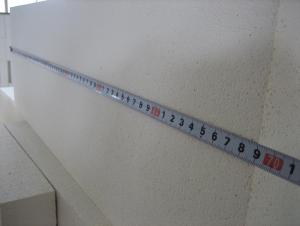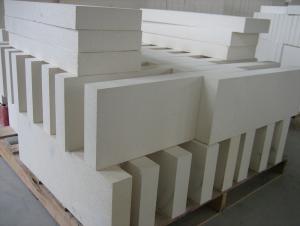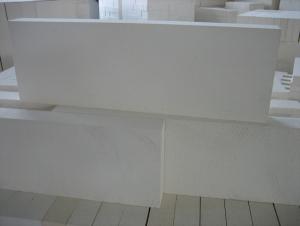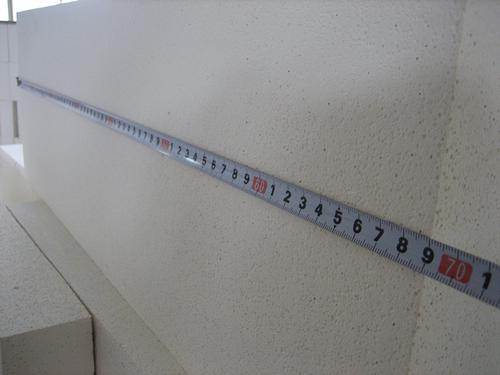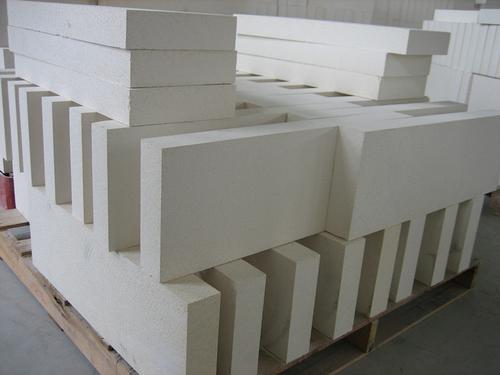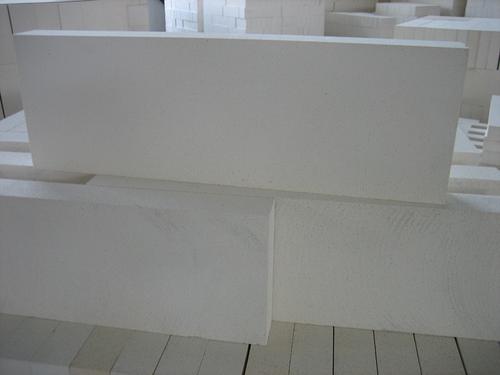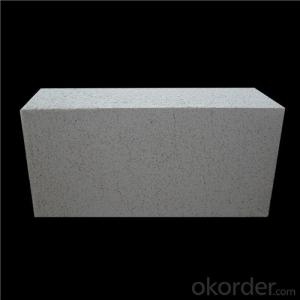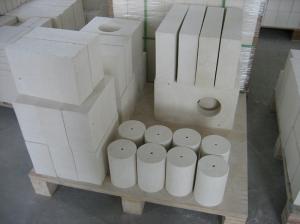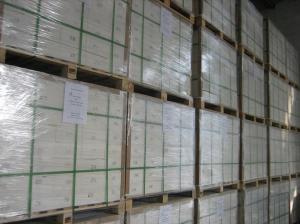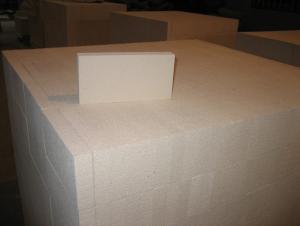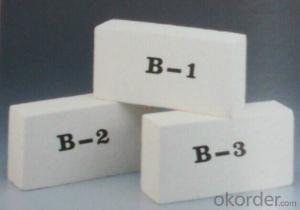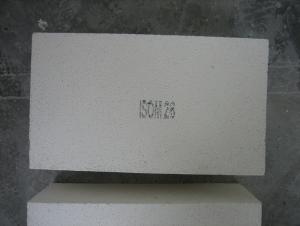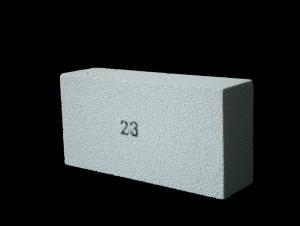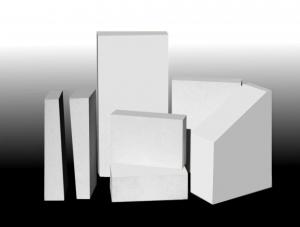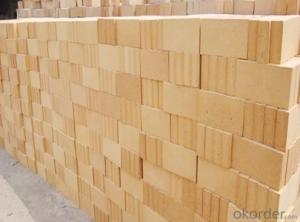Insulating Fire Brick - Mullite JM 36 Refractory Insulating Brick
- Loading Port:
- Shanghai
- Payment Terms:
- TT OR LC
- Min Order Qty:
- 20 m.t.
- Supply Capability:
- 20 m.t./month
OKorder Service Pledge
OKorder Financial Service
You Might Also Like
General Information
CMAX insulating firebricks are classified under temperature between 1300℃ to 1700℃, manufactured from high purity alumina clay.
1. Lower content of iron, alkaline and impurities, good high temperature properties.
2. Homogeneous structure, light weight, energy saving because lower heat storage in the furnace during cooling cycles.
3. High strength, good thermal shock resistance under high temperature.
4. Precise sizes due to grinding and shaping after sintering, which meets the requirement of construction.
5. Max service temp: Up to 1730C (3160F)
Feature
Light weight and low thermal conductivity
Low heat storage
Low iron and impurities
High thermal shock resistance
Application of Insulating brick
Metallurgical Industry: blast furnace, hot blast furnace, heating furnace, etc..
Petrochemical Industry: ethylene cracking furnace, hydrogen furnace, the main furnace, heating furnace, etc..
Ceramic industry: roller kiln, kiln, etc..
Glass industry: glass furnace regenerator, etc.
Carbon industry: carbon furnace, etc..
Aluminum electrolysis industry: aluminum reduction cell, etc.
Other industries: tunnel kiln, shuttle kiln, etc.
Advantages of heat insulation brick
Low thermal conductivity: many air holes will bring good thermal insulation effect, energy saving.
High crushing strength: high crushing strength, volume stability.
Low heat storage: small heat storage, absorb more heat, energy-saving effect is obvious.
Technical Data
ITEM | GJM30 | GJM28 | GJM26 | GJM23 |
Classification Temperature, ℉/℃ | 3000/1650 | 2800/1540 | 2600/1430 | 2300/1260 |
Bulk Density,g/cm³ | ≤1.0 | ≤0.9 | ≤0.8 | ≥0.5 |
Reheating Linear Change, % | ≤0.9 (1550℃,12 h) | ≤0.8 (1510℃,12 h) | ≤0.7 (1410℃,12 h) | ≤0.5 (1230℃,12 h) |
Al2O3 Content, % | ≥75 | ≥65 | ≥55 | ≥45 |
Fe2O3 Content, % | ≤0.5 | ≤0.6 | ≤0.7 | ≤1.0 |
Thermal Conductivity: | ||||
800℃, w/m.k | ≤0.39 | ≤0.37 | ≤0.35 | ≤0.18 |
1000℃, w/m.k | ≤0.43 | ≤0.41 | ≤0.39 | ≤0.20 |
1200℃, w/m.k | ≤0.48 | ≤0.46 | ≤0.43 | --- |
Insulating brick
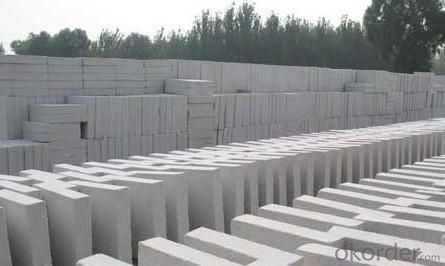
- Q: Can insulating fire bricks be used in the construction of glassware production furnaces?
- Yes, insulating fire bricks can be used in the construction of glassware production furnaces. Insulating fire bricks are designed to have low thermal conductivity, which means they are able to withstand high temperatures while providing effective insulation. This makes them ideal for use in furnaces where glassware production takes place, as they help to retain heat and minimize energy loss. Additionally, insulating fire bricks are resistant to thermal shock, which is important in glassware production where rapid temperature changes can occur. Overall, the use of insulating fire bricks in the construction of glassware production furnaces helps to ensure efficient and safe operation of the equipment.
- Q: Can insulating fire bricks be used as a lining for boilers?
- Yes, insulating fire bricks can be used as a lining for boilers. Insulating fire bricks are designed to withstand high temperatures and have excellent thermal insulation properties. They are commonly used in applications where heat retention and energy efficiency are important, such as in industrial boilers. The insulating properties of these bricks help to reduce heat loss and increase the efficiency of the boiler. Additionally, their durability and resistance to thermal shock make them suitable for use in boiler linings, where they can withstand the extreme conditions and fluctuations in temperature.
- Q: Are insulating fire bricks resistant to insect infestations?
- While insulating fire bricks are primarily designed to offer exceptional thermal resistance, they do not possess specific features to combat insect infestations. Nevertheless, owing to their dense and sturdy composition, these bricks can serve as a physical barrier against insects, rendering it arduous for them to infiltrate or burrow into the bricks. Moreover, the elevated temperatures that insulating fire bricks can endure might discourage insects from nesting or infesting them. Nevertheless, it is crucial to acknowledge that no material is entirely impervious to insect infestations, and if there exist any cracks or gaps within the bricks, insects may still find their way inside. Conducting regular inspections and maintenance is indispensable to ensure the integrity of the bricks and preempt any prospective insect infestations.
- Q: What is the typical weight of an insulating fire brick?
- The weight of an insulating fire brick can differ based on its specific type and manufacturer. On average, it falls within the range of 2.5 to 3.5 pounds (1.1 to 1.6 kilograms). It's worth noting that this weight estimation applies to a standard-sized brick measuring 9 x 4.5 x 2.5 inches (22.9 x 11.4 x 6.4 centimeters). Slight variations in weight may occur due to varying densities and compositions of these bricks. Therefore, it is advisable to consult the manufacturer's specifications for precise information.
- Q: Are insulating fire bricks suitable for insulation in boilers for steam generation?
- Yes, insulating fire bricks are suitable for insulation in boilers for steam generation. These bricks have excellent thermal insulation properties, high heat resistance, and low thermal conductivity, making them ideal for reducing heat loss and improving the energy efficiency of boilers. Additionally, their lightweight and durable nature allow for easy installation and long-term performance in high-temperature environments.
- Q: Do insulating fire bricks require special installation techniques?
- Special installation techniques are not necessarily required for insulating fire bricks, although there are certain factors to consider during the installation process. These bricks are designed to withstand high temperatures and provide thermal insulation, making them perfect for lining fireplaces, kilns, furnaces, and other applications that involve high temperatures. Although the installation process may differ depending on the specific application, there are general guidelines to follow. First and foremost, it is crucial to ensure that the surface where the bricks will be installed is clean and free from debris. This will assist in proper adhesion of the bricks and guarantee a secure installation. It is advisable to use a high-temperature refractory mortar or adhesive to bond the bricks together and to the surface. This mortar should be specifically formulated for high-temperature applications to ensure durability and heat resistance. It is essential to adhere to the manufacturer's instructions for mixing and applying the mortar. To maximize the insulating properties of the bricks, it is vital to achieve proper alignment and tight joints during the installation process. This can be accomplished by using a level and a rubber mallet to carefully position the bricks, ensuring they are evenly and tightly placed. Furthermore, it is important to account for the expansion and contraction of the bricks caused by the high temperatures they will be exposed to. This can be accomplished by leaving small gaps between the bricks and using expansion joints or flexible materials in areas where movement is anticipated. Finally, it is recommended to consult the manufacturer's guidelines and recommendations for specific installation techniques and considerations. Different types of insulating fire bricks may have slightly different requirements, so it is important to follow the instructions provided by the manufacturer. In conclusion, while insulating fire bricks do not demand complex installation techniques, it is crucial to pay attention to details and adhere to the recommended guidelines to ensure a successful and long-lasting installation.
- Q: Are insulating fire bricks resistant to acid attack?
- Yes, insulating fire bricks are resistant to acid attack.
- Q: How does the density of an insulating fire brick affect its performance?
- The density of an insulating fire brick directly affects its performance. A higher density brick usually offers better insulation properties, as it contains more air pockets that prevent heat transfer. On the other hand, a lower density brick may have reduced insulation capabilities but can be more lightweight and easier to handle. Therefore, selecting the appropriate density for an insulating fire brick is crucial in achieving the desired level of insulation and overall performance.
- Q: What is the recommended method for installing insulating fire bricks?
- The recommended method for installing insulating fire bricks is to first prepare the surface by cleaning it thoroughly and ensuring it is dry. Then, apply a thin layer of refractory mortar to the surface where the bricks will be placed. Carefully lay the bricks in a tight, staggered pattern, pressing them firmly into the mortar. Use a level to ensure they are properly aligned. Allow the mortar to dry completely before subjecting the bricks to heat.
- Q: Do insulating fire bricks require any special insulation blankets or jackets?
- Insulating fire bricks (IFBs) are designed to have excellent insulating properties, so they generally do not require any special insulation blankets or jackets. However, depending on the specific application and environment, additional insulation may be needed. If the IFBs are exposed to high temperatures or extreme thermal conditions, it may be beneficial to use insulation blankets or jackets to further enhance their insulation capabilities and protect them from damage. These additional insulation materials can help reduce heat loss, increase energy efficiency, and extend the lifespan of the IFBs. Therefore, while not always necessary, it is worth considering using insulation blankets or jackets in certain situations to optimize the performance of insulating fire bricks.
Send your message to us
Insulating Fire Brick - Mullite JM 36 Refractory Insulating Brick
- Loading Port:
- Shanghai
- Payment Terms:
- TT OR LC
- Min Order Qty:
- 20 m.t.
- Supply Capability:
- 20 m.t./month
OKorder Service Pledge
OKorder Financial Service
Similar products
Hot products
Hot Searches
Related keywords
